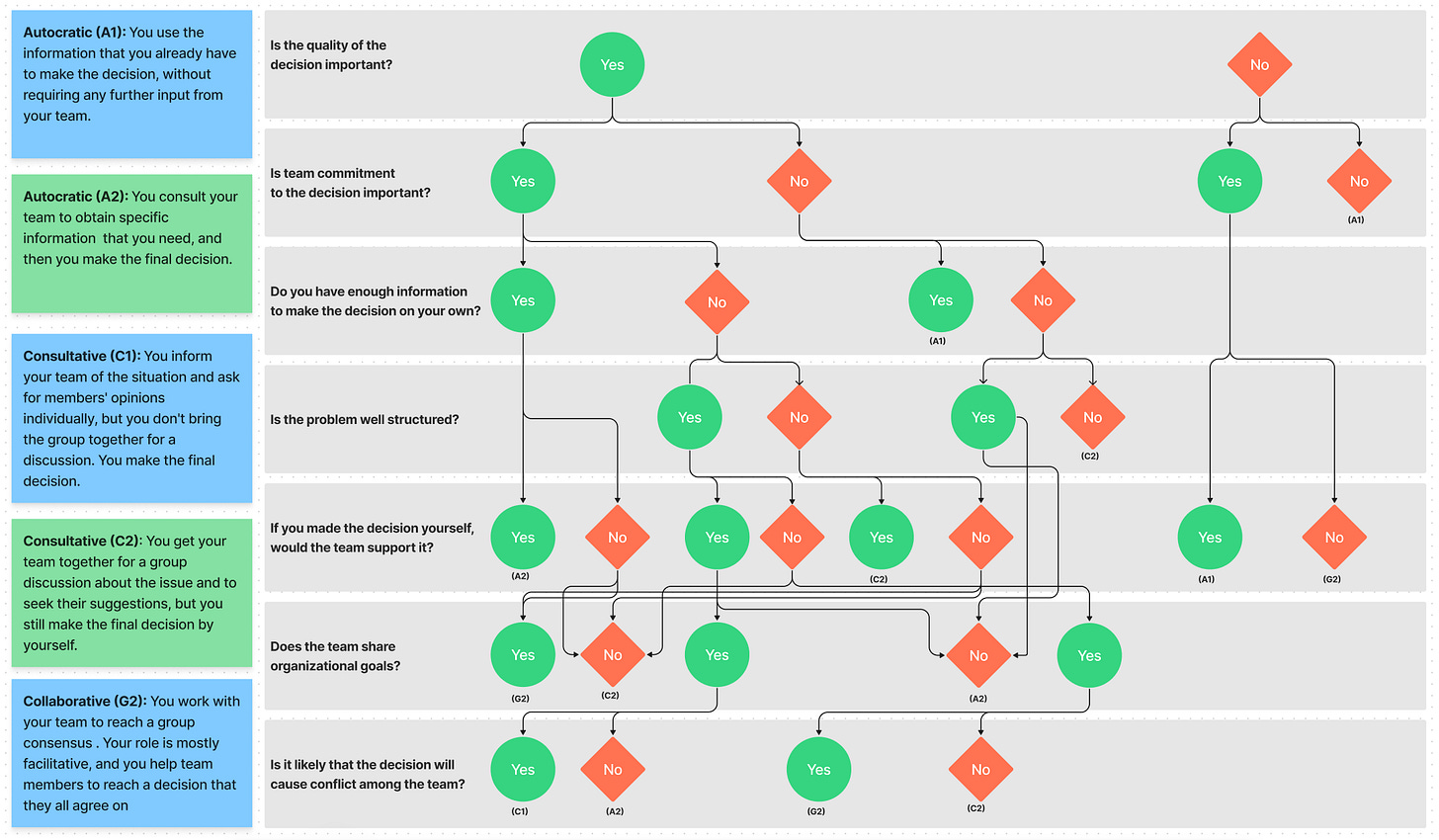
Ever felt deciding the family's weekly menu was a high-stakes game of culinary organization? Well, imagine navigating the complex world of leadership decisions where every move could shape the future of your team or organization. It's a universe where "Should we have tacos on Tuesday?" pales in comparison to the weightier "Should we launch this product now or wait for more data?" Thankfully, there's a smart way to navigate these decisions.
Enter the Vroom-Yetton decision model.
No, it's not the latest model of a sports car, but it certainly puts you in the driver's seat of decision-making.
The Essence of the Model
Developed by Victor Vroom and Philip Yetton, this model is a psychological take on leadership and decision-making. It’s like a Choose Your Own Adventure book for leaders, offering a series of if-then scenarios that guide you toward the most effective involvement level in decision processes. The model identifies five different leadership styles, ranging from autocratic to consultative to group-based decisions, depending on the situation's specifics.
How Does It Work?
Imagine you're at a crossroads. One path leads to the autocratic decision route, where you call the shots alone. Another path takes you down the democratic road, where the team's input guides the way. The Vroom-Yetton model helps you decide which path to take based on factors like the importance of decision quality, the amount of information you have, and how much your team cares about the decision.
The Challenges of Decision-Making
Choosing the right path isn't always straightforward. One of the main hurdles in decision-making is knowing when to involve your team and to what extent. Lean too much on autocratic decisions, and you might find yourself facing a mutinous crew. Swing too far the other way, and you could end up circling in the sea of indecision. The Vroom-Yetton model provides a structured way to balance these considerations.
The Importance of a Good Decision-Making Process
Why bother with a model? Can't we just "go with the gut"? While instincts play a role, the stakes in leadership decisions often demand more. A structured decision-making process ensures that you're not just making choices, but making them for the right reasons.
Making the Right Call
The Vroom-Yetton Decision Model identifies five leadership styles, each with different degrees of team involvement:
A1 (Autocratic 1): The leader decides alone based on existing information, suitable for quick decisions when the leader has all needed info.
A2 (Autocratic 2): The leader collects information from the team but decides alone, allowing for more informed decisions while retaining control.
C1 (Consultative 1): The leader consults team members individually for input but makes the final decision alone, incorporating diverse perspectives without group discussion.
C2 (Consultative 2): The leader discusses the problem with the team collectively and seeks suggestions, but ultimately decides alone, enhancing team involvement.
G2 (Group 2): The leader and team work together to make a collective decision, maximizing team input and commitment, ideal for complex issues requiring consensus.
Here are some examples of questions that might prompt the use of different styles within this model:
Should we pivot our product strategy to enter a new market? Likely a C2 or G2 situation, as team input and buy-in are crucial for such a significant strategic shift.
Which feature should we prioritize in the next product release? C1 or C2 could be suitable, depending on how much the leader values team input versus needing to make a quick decision.
Do we need to cut features to meet the launch deadline? A1 or C1 might be appropriate, as the leader might need to gather specific information from team members but still make a quick decision.
How should we respond to a critical bug affecting major customers? A1 or A2 might be used if the leader has the expertise to decide quickly or needs specific technical information from a few team members.
What should our response be to a competitor's newly announced product? C2 or G2 would be fitting, encouraging open discussion and collective decision-making to form a strategic response.
How do we allocate our budget between product development and marketing? C1 or C2, where the leader seeks input from both the product and marketing teams before making a final decision.
Each question highlights a scenario where different levels of team involvement are beneficial, demonstrating the Vroom-Yetton model's flexibility in guiding leaders to the most appropriate decision-making style.
Happy decision making!





